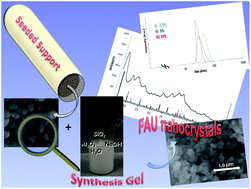Low temperature synthesis of nanosized NaY zeolite crystals from organic-free gel by using supported seeds†
Abstract
Zeolite crystals having faujasite-type (FAU) topology and particle size distribution in the nanometer range have been successfully prepared by a room temperature, short duration synthesis, in the absence of organic structure directing agents (SDAs). The use of NaX seeds anchored on α-Al2O3 tubular supports, jointly with the optimal composition of the precursor gel system, allowed control of the zeolite nanocrystal size and phase purity, and allowed reaching of a high degree of conversion of the precursor gel system into a nanocrystalline material under near ambient conditions. The X-ray diffraction (XRD) pattern collected on the samples confirmed the structural features reported for a FAU(Y) phase. The particle size of the zeolite nanocrystals was strongly dependent on the amount of seeds anchored on the supports. The mean particle size of different samples was estimated by SEM and measured by DLS, with similar results falling in the range of 35–60 nm. SEM observations also revealed that aggregates of primary crystals are present, whose size is still in the nanometer range. The synthesis approach described in the present study effectively addresses some significant issues related to the classical seeded syntheses and offers good opportunities for industrial applications. In particular, this novel synthetic route allows avoidance of tedious purification procedures and effectively reduces the cost of the zeolite synthesis.


 Please wait while we load your content...
Please wait while we load your content...